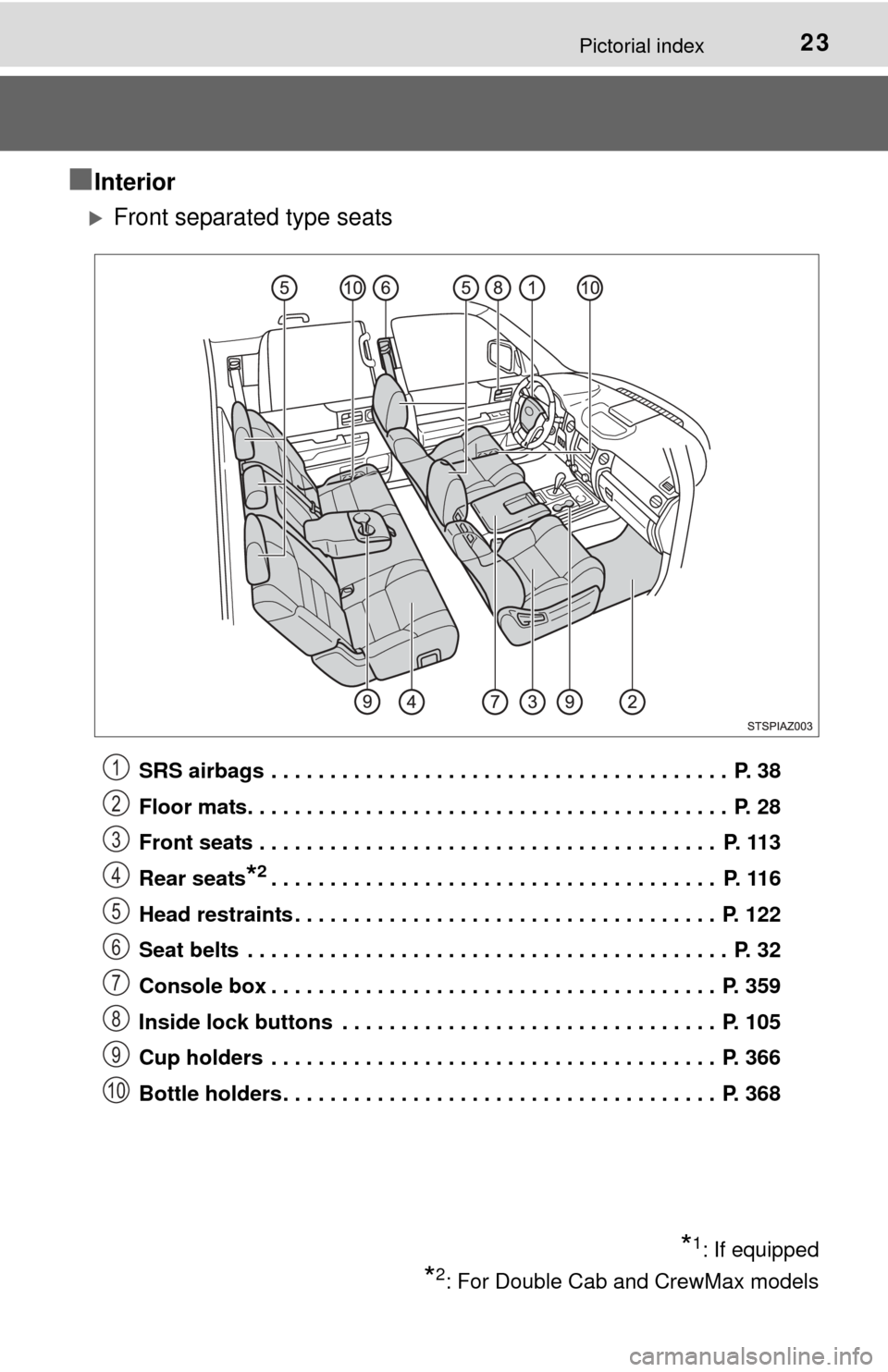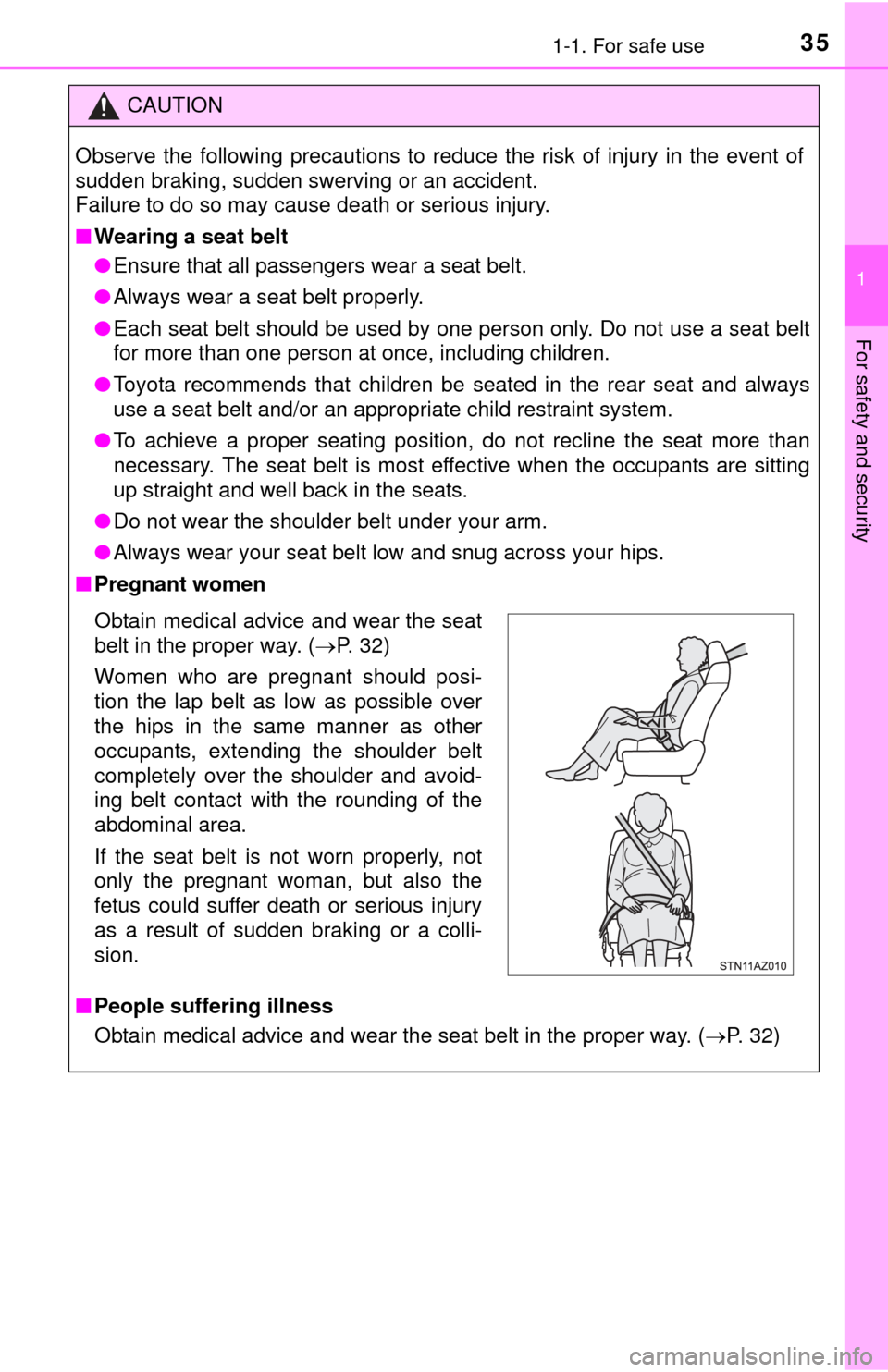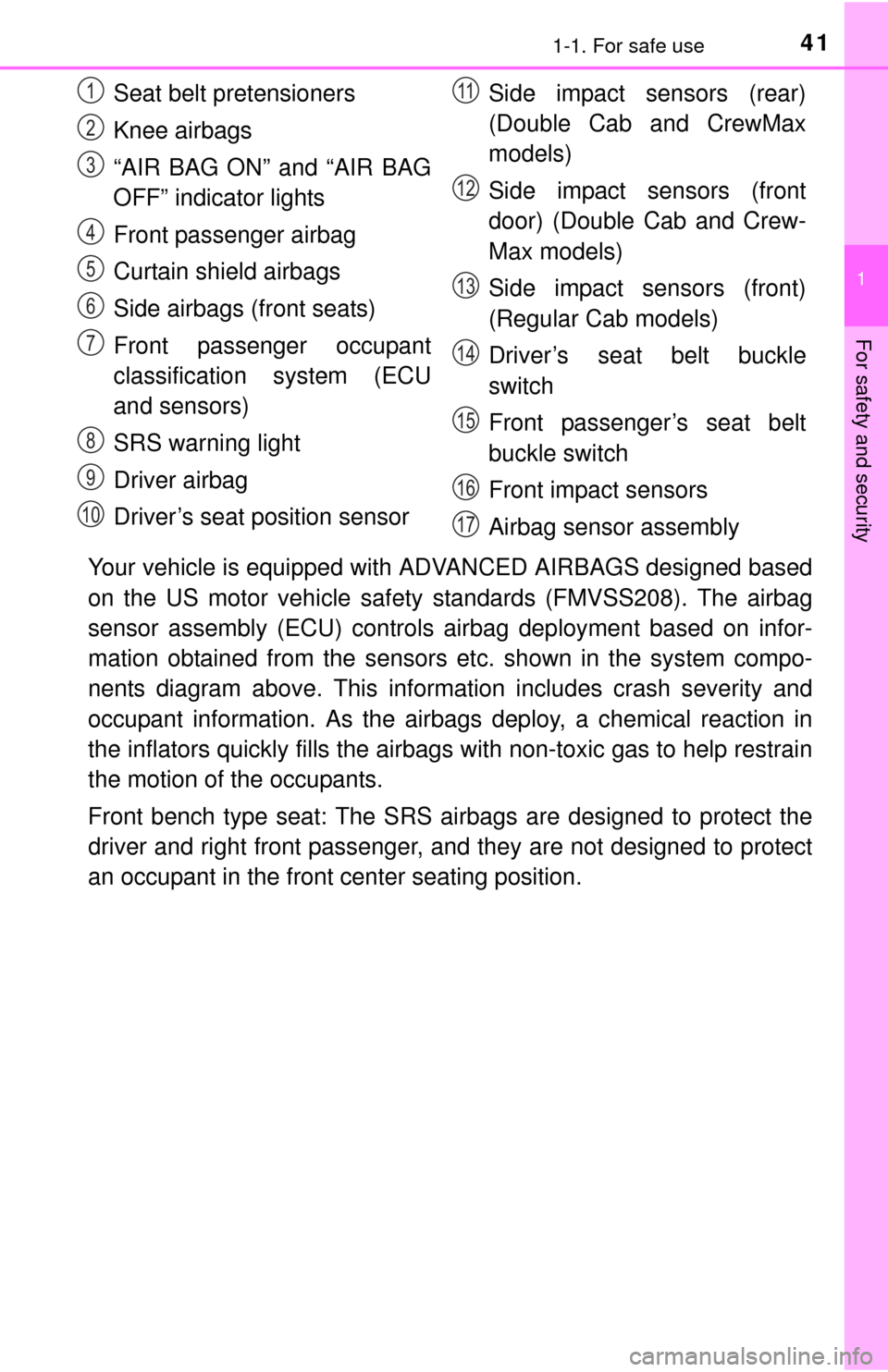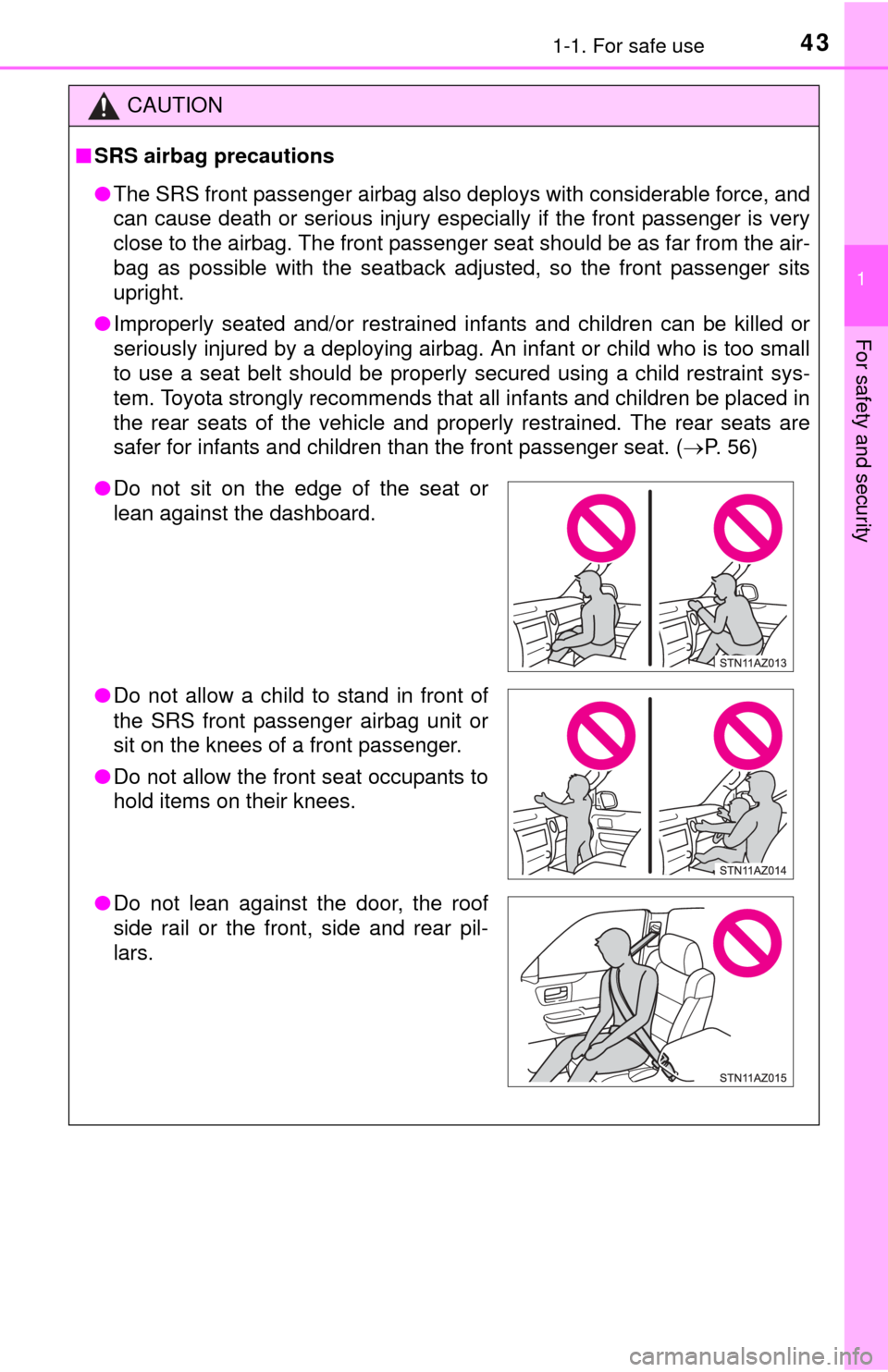seats TOYOTA TUNDRA 2014 2.G Owners Manual
[x] Cancel search | Manufacturer: TOYOTA, Model Year: 2014, Model line: TUNDRA, Model: TOYOTA TUNDRA 2014 2.GPages: 576, PDF Size: 10.54 MB
Page 2 of 576

TABLE OF CONTENTS2
For your information....................... 8
Reading this manual .................... 12
How to search .............................. 13
Pictorial index .............................. 14
1-1. For safe useBefore driving ...................... 28
For safety drive ................... 30
Seat belts ............................ 32
SRS airbags ........................ 38
Front passenger occupant classification system ......... 50
Safety information for children ........................ 55
Child restraint systems ........ 56
Installing child restraints ...... 60
Exhaust gas precautions ..... 77
1-2. Theft deterrent system Engine immobilizer system............................... 78
Alarm ................................... 80
2. Instrument cluster Warning lights and indicators........................... 84
Gauges and meters............. 88
Trip information display ....... 91
Multi-information display ..... 93 3-1. Key information
Keys................................... 100
3-2. Opening, closing and locking the doors
Side doors ......................... 102
Tailgate .............................. 108
3-3. Adjusting the seats Front seats......................... 113
Rear seats (Double Cab and CrewMax
models)............................ 116
Driving position memory (driver’s seat)................... 118
Head restraints .................. 122
3-4. Adjusting the steering wheel and mirrors
Steering wheel ................... 126
Inside rear view mirror ....... 129
Outside rear view mirrors ............................. 132
3-5. Opening, closing the windows and moon roof
Power windows.................. 136
Back window...................... 139
Power back window ........... 140
Moon roof .......................... 142
1For safety and security
2Instrument cluster
3Operation of
each component
Page 16 of 576

16Pictorial index
■Instrument panel
Front separated type seats
Engine switch . . . . . . . . . . . . . . . . . . . . . . . . . . . . . . . . . . . . . P. 179
Starting the engine/changing the positions . . . . . . . . . . . . . . . P. 179
Emergency stop of the engine . . . . . . . . . . . . . . . . . . . . . . . . . P. 457
When the engine will not start . . . . . . . . . . . . . . . . . . . . . . . . . P. 490
Shift lever . . . . . . . . . . . . . . . . . . . . . . . . . . . . . . . . . . . . . . . . P. 181
Changing the shift position. . . . . . . . . . . . . . . . . . . . . . . . . . . . P. 181
Precautions against towing . . . . . . . . . . . . . . . . . . . . . . . . . . . P. 458
When the shift lever does not move. . . . . . . . . . . . . . . . . . . . . P. 491
Meters . . . . . . . . . . . . . . . . . . . . . . . . . . . . . . . . . . . . . . . . . . . . P. 88
Reading the meters/adjusting the instrument panel light . . . . . . P. 88
Warning lights/indicator lights . . . . . . . . . . . . . . . . . . . . . . . . . . P. 84
When the warning lights come on . . . . . . . . . . . . . . . . . . . . . . P. 464
Multi-information display . . . . . . . . . . . . . . . . . . . . . . . . . . . . P. 93
Display . . . . . . . . . . . . . . . . . . . . . . . . . . . . . . . . . . . . . . . . . . . . P. 93
When the warning messages are displayed . . . . . . . . . . . . . . P. 472
Parking brake pedal. . . . . . . . . . . . . . . . . . . . . . . . . . . . . . . . P. 187
Applying/releasing . . . . . . . . . . . . . . . . . . . . . . . . . . . . . . . . . . P. 187
Precautions against winter season . . . . . . . . . . . . . . . . . . . . . P. 241
Warning buzzer/message
*2. . . . . . . . . . . . . . . . . . . . . . . P. 464, 473
1
2
3
4
5
Page 23 of 576

23Pictorial index
■Interior
Front separated type seats
SRS airbags . . . . . . . . . . . . . . . . . . . . . . . . . . . . . . . . . . . . . . . P. 38
Floor mats. . . . . . . . . . . . . . . . . . . . . . . . . . . . . . . . . . . . . . . . . P. 28
Front seats . . . . . . . . . . . . . . . . . . . . . . . . . . . . . . . . . . . . . . . P. 113
Rear seats
*2. . . . . . . . . . . . . . . . . . . . . . . . . . . . . . . . . . . . . . P. 116
Head restraints . . . . . . . . . . . . . . . . . . . . . . . . . . . . . . . . . . . . P. 122
Seat belts . . . . . . . . . . . . . . . . . . . . . . . . . . . . . . . . . . . . . . . . . P. 32
Console box . . . . . . . . . . . . . . . . . . . . . . . . . . . . . . . . . . . . . . P. 359
Inside lock buttons . . . . . . . . . . . . . . . . . . . . . . . . . . . . . . . . P. 105
Cup holders . . . . . . . . . . . . . . . . . . . . . . . . . . . . . . . . . . . . . . P. 366
Bottle holders . . . . . . . . . . . . . . . . . . . . . . . . . . . . . . . . . . . . . P. 368
*1: If equipped
*2: For Double Cab and CrewMax models
1
2
3
4
5
6
7
8
9
10
Page 24 of 576

24Pictorial index
Front bench type seat
SRS airbags . . . . . . . . . . . . . . . . . . . . . . . . . . . . . . . . . . . . . . . P. 38
Floor mats. . . . . . . . . . . . . . . . . . . . . . . . . . . . . . . . . . . . . . . . . P. 28
Front seats . . . . . . . . . . . . . . . . . . . . . . . . . . . . . . . . . . . . . . . P. 113
Rear seats
*1. . . . . . . . . . . . . . . . . . . . . . . . . . . . . . . . . . . . . . P. 116
Head restraints . . . . . . . . . . . . . . . . . . . . . . . . . . . . . . . . . . . . P. 122
Seat belts . . . . . . . . . . . . . . . . . . . . . . . . . . . . . . . . . . . . . . . . . P. 32
Inside lock buttons . . . . . . . . . . . . . . . . . . . . . . . . . . . . . . . . P. 105
Cup holders . . . . . . . . . . . . . . . . . . . . . . . . . . . . . . . . . . . . . . P. 366
Bottle holders . . . . . . . . . . . . . . . . . . . . . . . . . . . . . . . . . . . . . P. 368
1
2
3
4
5
6
7
8
9
Page 31 of 576

311-1. For safe use
1
For safety and security
CAUTION
Observe the following precautions.
Failure to do so may result in death or serious injury.
●Do not adjust the position of the driver’s seat while driving.
Doing so could cause the driver to lose control of the vehicle.
● Do not place a cushion between the driver or passenger and the seatback.
A cushion may prevent correct posture from being achieved, and reduce
the effectiveness of the seat belt and head restraint.
● Do not place anything under the front seats.
Objects placed under the front seats may become jammed in the seat
tracks and stop the seat from locking in place. This may lead to an acci-
dent and the adjustment mechanism may also be damaged.
● When driving over long distances, take regular breaks before you start to
feel tired.
Also, if you feel tired or sleepy while driving, do not force yourself to con-
tinue driving and take a break immediately.
Page 33 of 576

331-1. For safe use
1
For safety and security
Push the seat belt shoulder anchor down while pressing the release
button.
Push the seat belt shoulder anchor up.
Move the height adjuster up and down as needed until you hear a click.
The pretensioners help the seat
belts to quickly restrain the occu-
pants by retracting the seat belts
when the vehicle is subjected to
certain types of severe frontal or
side collision or a vehicle rollover.
The pretensioners do not activate
in the event of a minor frontal
impact, a minor side impact or a
rear impact.
Adjusting the seat belt shoulder anchor height (Double Cab and
CrewMax models)
1
2
Front seatsRear seats (CrewMax models)
Seat belt pretensioners (front seats)
Page 35 of 576

351-1. For safe use
1
For safety and security
CAUTION
Observe the following precautions to reduce the risk of injury in the event of
sudden braking, sudden swerving or an accident.
Failure to do so may cause death or serious injury.
■Wearing a seat belt
● Ensure that all passengers wear a seat belt.
● Always wear a seat belt properly.
● Each seat belt should be used by one person only. Do not use a seat belt
for more than one person at once, including children.
● Toyota recommends that children be seated in the rear seat and always
use a seat belt and/or an appropriate child restraint system.
● To achieve a proper seating position, do not recline the seat more than
necessary. The seat belt is most effective when the occupants are sitting
up straight and well back in the seats.
● Do not wear the shoulder belt under your arm.
● Always wear your seat belt low and snug across your hips.
■ Pregnant women
■ People suffering illness
Obtain medical advice and wear the seat belt in the proper way. ( P. 32)
Obtain medical advice and wear the seat
belt in the proper way. (P. 32)
Women who are pregnant should posi-
tion the lap belt as low as possible over
the hips in the same manner as other
occupants, extending the shoulder belt
completely over the shoulder and avoid-
ing belt contact with the rounding of the
abdominal area.
If the seat belt is not worn properly, not
only the pregnant woman, but also the
fetus could suffer death or serious injury
as a result of sudden braking or a colli-
sion.
Page 39 of 576

391-1. For safe use
1
For safety and security
◆SRS front airbags
SRS driver airbag/front passenger airbag
Can help protect the head and chest of the driver and right front
passenger from impact with interior components
SRS knee airbags
Can help provide driver and front passenger protection
◆SRS side and curtain shield airbags
SRS side airbags
Can help protect the torso of the front seat occupants
SRS curtain shield airbags
●Can help protect primarily the head of occupants in the outer
seats
● Can prevent the occupants from being thrown from the vehicle in
the event of vehicle rollover
1
2
3
4
Page 41 of 576

411-1. For safe use
1
For safety and security
Your vehicle is equipped with ADVANCED AIRBAGS designed based
on the US motor vehicle safety standards (FMVSS208). The airbag
sensor assembly (ECU) controls airbag deployment based on infor-
mation obtained from the sensors et c. shown in the system compo-
nents diagram above. This informat ion includes crash severity and
occupant information. As the airbags deploy, a chemical reaction in
the inflators quickly fills the airbag s with non-toxic gas to help restrain
the motion of the occupants.
Front bench type seat: The SRS airbags are designed to protect the
driver and right front passenger, and they are not designed to protect
an occupant in the front center seating position. Seat belt pretensioners
Knee airbags
“AIR BAG ON” and “AIR BAG
OFF” indicator lights
Front passenger airbag
Curtain shield airbags
Side airbags (front seats)
Front passenger occupant
classification system (ECU
and sensors)
SRS warning light
Driver airbag
Driver’s seat position sensor
Side impact sensors (rear)
(Double Cab and CrewMax
models)
Side impact sensors (front
door) (Double Cab and Crew-
Max models)
Side impact sensors (front)
(Regular Cab models)
Driver’s seat belt buckle
switch
Front passenger’s seat belt
buckle switch
Front impact sensors
Airbag sensor assembly
1
2
3
4
5
6
7
8
9
10
11
12
13
14
15
16
17
Page 43 of 576

431-1. For safe use
1
For safety and security
CAUTION
■SRS airbag precautions
● The SRS front passenger airbag also deploys with considerable force, and
can cause death or serious injury especially if the front passenger is very
close to the airbag. The front passenger seat should be as far from the air-
bag as possible with the seatback adjusted, so the front passenger sits
upright.
● Improperly seated and/or restrained infants and children can be killed or
seriously injured by a deploying airbag. An infant or child who is too small
to use a seat belt should be properly secured using a child restraint sys-
tem. Toyota strongly recommends that all infants and children be placed in
the rear seats of the vehicle and proper ly restrained. The rear seats are
safer for infants and children than the front passenger seat. (P. 56)
● Do not sit on the edge of the seat or
lean against the dashboard.
● Do not allow a child to stand in front of
the SRS front passenger airbag unit or
sit on the knees of a front passenger.
● Do not allow the front seat occupants to
hold items on their knees.
● Do not lean against the door, the roof
side rail or the front, side and rear pil-
lars.